Chương 2 – Các Giai Đoạn Tuệ – Wisdom Stages – Song ngữ
Vipassanā Bhāvanā – Mind Development through Insight
Minh Sát Tu Tập
English: Achaan Naeb Mahaniranonda- Boonkanjanaram Meditation Cente
Việt ngữ: Tỳ kheo Pháp Thông
Compile: Lotus group
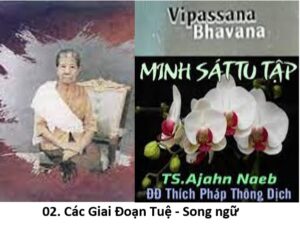
Chương 2 – Các Giai Đoạn Tuệ – Wisdom Stages – Song ngữ
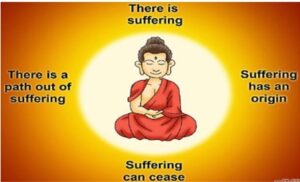
Ở giai đoạn trí tuệ đầu tiên, được gọi Tuệ thật- sacca-ñāṇa,
ngài nhận thức được: Tứ Thánh Đế: Khổ, Tập, Diệt, Đạo.
The Buddha passed through three stages in realizing the Four Noble Truths. He realized all three wisdom stages by himself, because there was no one to teach him.
Đức Phật trải qua ba giai đoạn chứng ngộ Tứ Thánh Đế. Ngài đã tự mình chứng ngộ ba giai đoạn tuệ này, không có ai là thầy của Ngài.
- Tuệ thật (Cacca-ñāṇa)
Trí Tuệ thấy rõ Sự Thực
In the first wisdom stage, called sacca-nana, he realized:
Ở giai đoạn tuệ đầu tiên, gọi là “Sự Thực Trí”, Ngài chứng ngộ Tứ Thánh Đế:
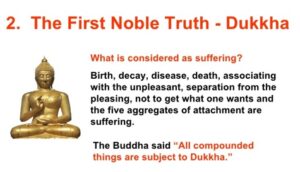 Khổ Đế (Dukkhasacca) gồm mười một loại: sanh, già, bệnh, chết, sầu, bi, khổ, ưu, não, gần người không ưa, xa người thương mến, không đạt được điều mình muốn. Có những khổ này là do chấp thủ vào Năm uẩn.
Khổ Đế (Dukkhasacca) gồm mười một loại: sanh, già, bệnh, chết, sầu, bi, khổ, ưu, não, gần người không ưa, xa người thương mến, không đạt được điều mình muốn. Có những khổ này là do chấp thủ vào Năm uẩn.
1) The Truth of Suffering (Dukkha Sacca) which has eleven types: birth (of FiveKhandhas), decay (old age of FiveKhandhas), death (of FiveKhandhas), sorrow, lamentation, pain (bodily), grief (mental suffering), despair, association with the unpleasant, separation from the pleasant, and not getting what you want. All dukkha is clinging caused by the Five Khandhas.
Khổ Đế (Dukkhasacca) gồm mười một loại: sanh, già, bệnh, chết, sầu, bi, khổ, ưu, não, gần người không ưa, xa người thương mến, không đạt được điều mình muốn. Có những khổ này là do chấp thủ vào Năm uẩn.
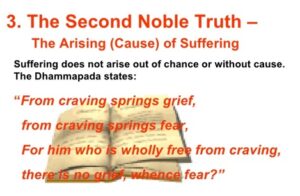 Nhân Sanh Khổ hay Tập Đế gồm: Dục ái (Kāmataṇhā), Hữu ái (Bhavataṇha), Phi hữu ái (Vibhavataṇha).
Nhân Sanh Khổ hay Tập Đế gồm: Dục ái (Kāmataṇhā), Hữu ái (Bhavataṇha), Phi hữu ái (Vibhavataṇha).
2) Cause of Suffering (Samudaya Sacca): kamatanha(sensual craving), bhavatanha(craving for existence), vibhavatanha(craving for non-existence). (See “Noble Truths”, 1.4.5)
Nhân Sanh Khổ hay Tập Đế (Samudayasacca) gồm Dục ái (Kāmataṇhā), Hữu ái (Bhavataṇha), Phi hữu ái (Vibhavataṇha). (Xem phần IV- Tứ Thánh Đế sau)
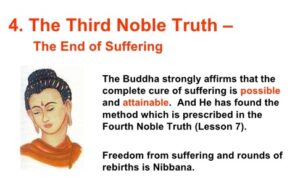 Sự Diệt Khổ hay Diệt Đế tức là Niết Bàn. Diệt ở đây là diệt nhân sanh khổ, dẫn đến quả khổ (dukkha) cũng bị diệt.
Sự Diệt Khổ hay Diệt Đế tức là Niết Bàn. Diệt ở đây là diệt nhân sanh khổ, dẫn đến quả khổ (dukkha) cũng bị diệt.
3) Cessation of Suffering (Nirodha Sacca): Nirodha (Nibbana) is the dhamma that extinguishes the cause of suffering (Samudaya Sacca) and the result (Dukkha Sacca). When the cause is extinguished, the result is extinguished.
Sự Diệt Khổ hay Diệt Đế (Nirodhasacca) tức là Niết Bàn. Diệt ở đây là diệt nhân sanh khổ (samadaya), dẫn đến quả khổ (dukkha) cũng bị diệt.
 Con Đường dẫn đến Sự Đoạn Khổ hay Đạo Đế là Bát Thánh Đạo, hay còn gọi là Trung Đạo (Majjhima Patipadā), là pháp hành duy nhất đưa đến chỗ diệt khổ.
Con Đường dẫn đến Sự Đoạn Khổ hay Đạo Đế là Bát Thánh Đạo, hay còn gọi là Trung Đạo (Majjhima Patipadā), là pháp hành duy nhất đưa đến chỗ diệt khổ.
4) The Path to End Suffering (Magga Sacca): The Eight-Fold Path is the Middle Way (Majjhima Patipata) and is the only practice that can reach Cessation of Suffering.
Con Đường dẫn đến Sự Đoạn Khổ hay Đạo Đế (Maggasacca) là Bát Thánh Đạo, hay còn gọi là Trung Đạo (Majjhima Patipadā), là pháp hành duy nhất đưa đến chỗ diệt khổ.
II. Tuệ hành (Kicca-ñāṇa)
Sở Dụng Trí
This is actual practice based on Stage I. Dukkha must be realized by practice; Samudaya must be eradicated by practice; Nirodha must be reached by practice; Magga Saccamust be developed by practiced.
Đây là pháp hành thực sự dựa trên giai đoạn một. Khổ (dukkha) phải được biết bằng pháp hành; Nhân Sanh Khổ (samudaya) phải được diệt trừ bằng pháp hành; Diệt (Nirodha) phải được chứng bằng pháp hành; Đạo (Magga) phải được tu bằng pháp hành.
III. Tuệ quả (Kata-ñāṇa)
Sở Tác trí
Kata-nana is fruition, or knowledge of what has been done with regard to the Four Noble Truths. The three yanas (sacca-nana, kicca-nana, kata-nana) are known as “Thrice-revolved knowledge and insight” ―the three aspects of intuitive knowledge regarding the Four Noble Truths.
Kata -ñāṇa là quả, tri kiến hiểu biết những gì đã được thực hiện liên quan đến Tứ Thánh Đế. Ba Tuệ (Sacca -ñāṇa, Kicca -ñāṇa, Kata -ñāṇa ) được gọi là Tam Tuệ Luân — ba phương diện của trực giác trí liên quan đến Tứ Thánh Đế.
The Buddha passed through these three stages of the Four Noble Truths on Enlightenment night (4×3=12 stages that he passed through). Then he realized
knowledge of the three yanas (sacca-nana, kicca-nana, kata-nana), each time with the Four Noble Truths.
Đức Phật đã trải qua ba giai đoạn tuệ trên trong đêm Giác Ngộ. Như vậy, Ngài đã biến tri Tam Tuệ, mỗi tuệ đem nhân với Tứ Thánh Đế thành 12 giai đoạn.
The yogi who wants to end suffering like the Buddha must understand the first wisdom (sacca-nana), then follow the practice and understand the practice too (kicca-nana). Then the two wisdoms have to work together, as we are doing now in practice.
Hành giả muốn đoạn tận khổ như Đức Phật cần phải hiểu Sự Thật Trí (Saccañāṇa); rồi theo pháp hành, đồng thời phải hiểu pháp hành này nữa, tức là Sở Dụng Trí (Kiccañāṇa). Khi ấy, hai loại trí tuệ này phải phối hợp với nhau, như hiện giờ chúng ta đang làm trong lúc thực hành.
If you realize the first wisdom (sacca-nana), and practice the second (kicca-nana), then times the Four Noble Truths we have 4 x 2 = 8, which is where your vipassana practice is now. If you realize result (kata-nana), it is 4 x 3 = 12, at which point the yogi reaches lokuttara dhamma (supramundane).
Nếu bạn hiểu tuệ đầu, và thực hành tuệ thứ hai, lúc ấy đem nhân với Tứ Thánh Đế, chúng ta có 4 x 2 = 8, đây là chỗ pháp hành minh sát của bạn hiện tại. Nếu bạn chứng quả (Katañāṇa), thì 4 x 3= 12, hành giả đạt đến Siêu Thế Pháp (Lokuttara Dhamma).
In the sermon delivered shortly after his enlightenment (“Setting in Motion the Wheel of Doctrine”), the Buddha described the 3 Wisdom Stages as follows:
Trong một pháp thoại ngắn sau khi giác ngộ, Đức Phật đã mô tả Tam Tuệ Luân này như sau:
And so long, monks, as the vision of knowledge of these four ariyan truths, with the 3 sections and 12 modes as they really are, was not well purified by me, so long was I, monks, not thoroughly awakened as to the world with its devas, with its Maras, with its Brahmas, with its recluses and brahmins, its creatures with devas and men. This I knew.
“… Này chư tỳ kheo, bao lâu tri kiến như thực về Tứ Thánh Đế, với ba luân chuyển và mười hai giai đoạn này chưa khéo thanh tịnh nơi ta, chừng ấy, này chư tỳ kheo, đối với thế giới Phạm thiên, với các sa môn và bà-la-môn, với tất cả chúng sinh trong thế giới chư thiên và nhân loại, Ta chưa tuyên bố đã giác ngộ hoàn toàn. Điều này Ta biết rõ.
But when, monks, the vision of knowledge of these four ariyan truths, with the 3 sections and 12 modes as they really are, was well purified by me, then was I, monks, thoroughly awakened with the supreme full awakening as to the world…This I knew.
“Nhưng này các tỳ kheo, khi tri kiến như thực về Tứ Thánh Đế, với ba luân chuyển và mười hai giai đoạn này đã khéo thanh tịnh nơi Ta, lúc ấy, này chư tỳ kheo, Ta tuyên bố đã giác ngộ hoàn toàn với sự giác ngộ viên mãn tối thượng đối với thế giới Phạm thiên, … Điều này Ta biết rõ.
Moreover, the vision of knowledge arose in me: “Freedom of mind is for me unshakeable, this is the last birth, there is not now again-becoming.”
(Book of the Discipline, IV, 16, 21)
“Lại nữa, tri kiến này khởi lên nơi Ta: “Bất động tâm giải thoát Ta đã chứng, kiếp này là kiếp chót, không còn phải tái sanh lại nữa.” (Vinaya, IV,16,21)

Sources:
Tài liệu tham khảo:
- https://tienvnguyen.net/images/file/Ek9kQjfF1wgQANp7/minhsattutap.pdf
- https://www.vipassanadhura.com/PDF/vipassanabhavana.pdf
- https://theravada.vn/minh-sat-tu-tap-chuong-ii-cac-giai-doan-tue/
- https://www.budsas.org/uni/u-gtmst/gtmst-11.htm
- Photo 1: https://dieuphapam.net/dpa/minh-sat-tu-tap.3982/
- Photo 2: http://evdhamma.org/index.php/dharma/dharma-lessons/item/178-17-tu-dieu-de-song-ng
- Photo 3: http://evdhamma.org/index.php/documents/buddhist-meditation/item/77-t-dieu-d-the-four-noble-truths-song-ngu
- Photo 4: https://www.slideshare.net/bugstan/buddhism-for-you-lesson-06the-four-noble-truths
- Photo 5: https://www.slideshare.net/bugstan/buddhism-for-you-lesson-06the-four-noble-truths
- Photo 6: http://evdhamma.org/index.php/dharma/dharma-lessons/item/300-55-banh-xe-chanh-phap-phan-2-song-ngu
- Photo 7: https://m.facebook.com/profile.php?id=166224440236784
